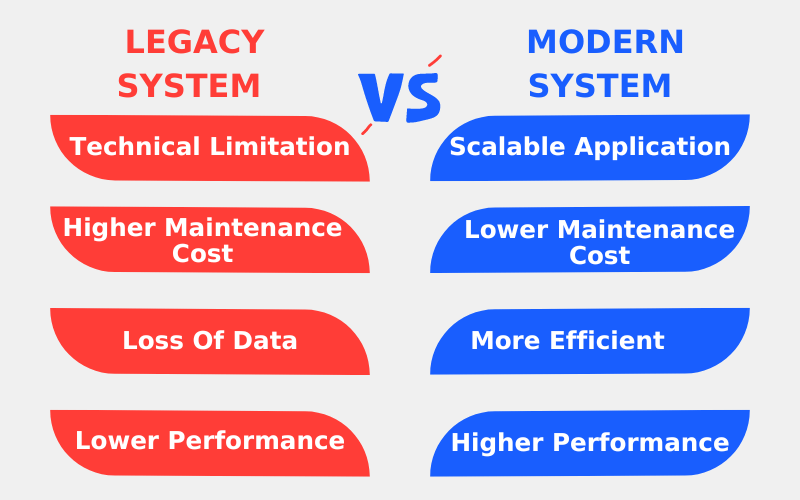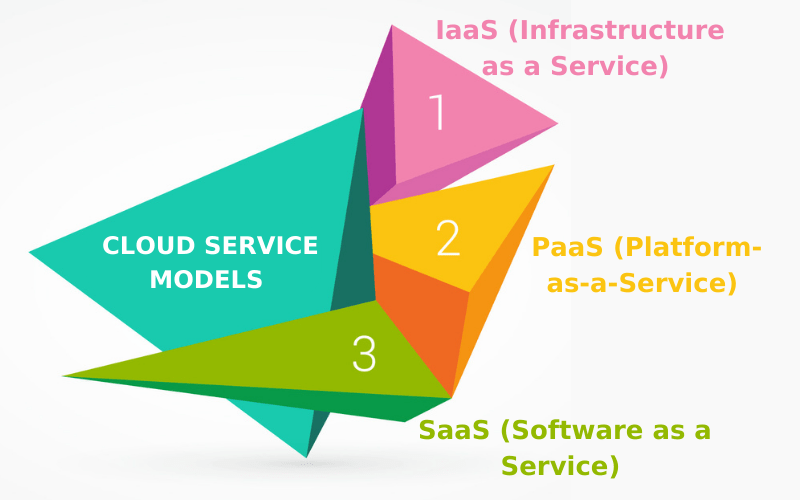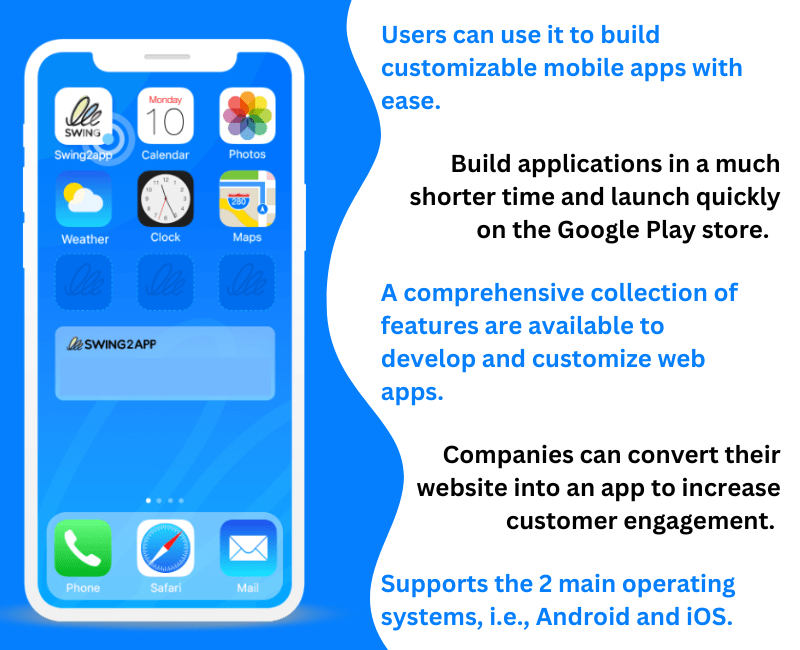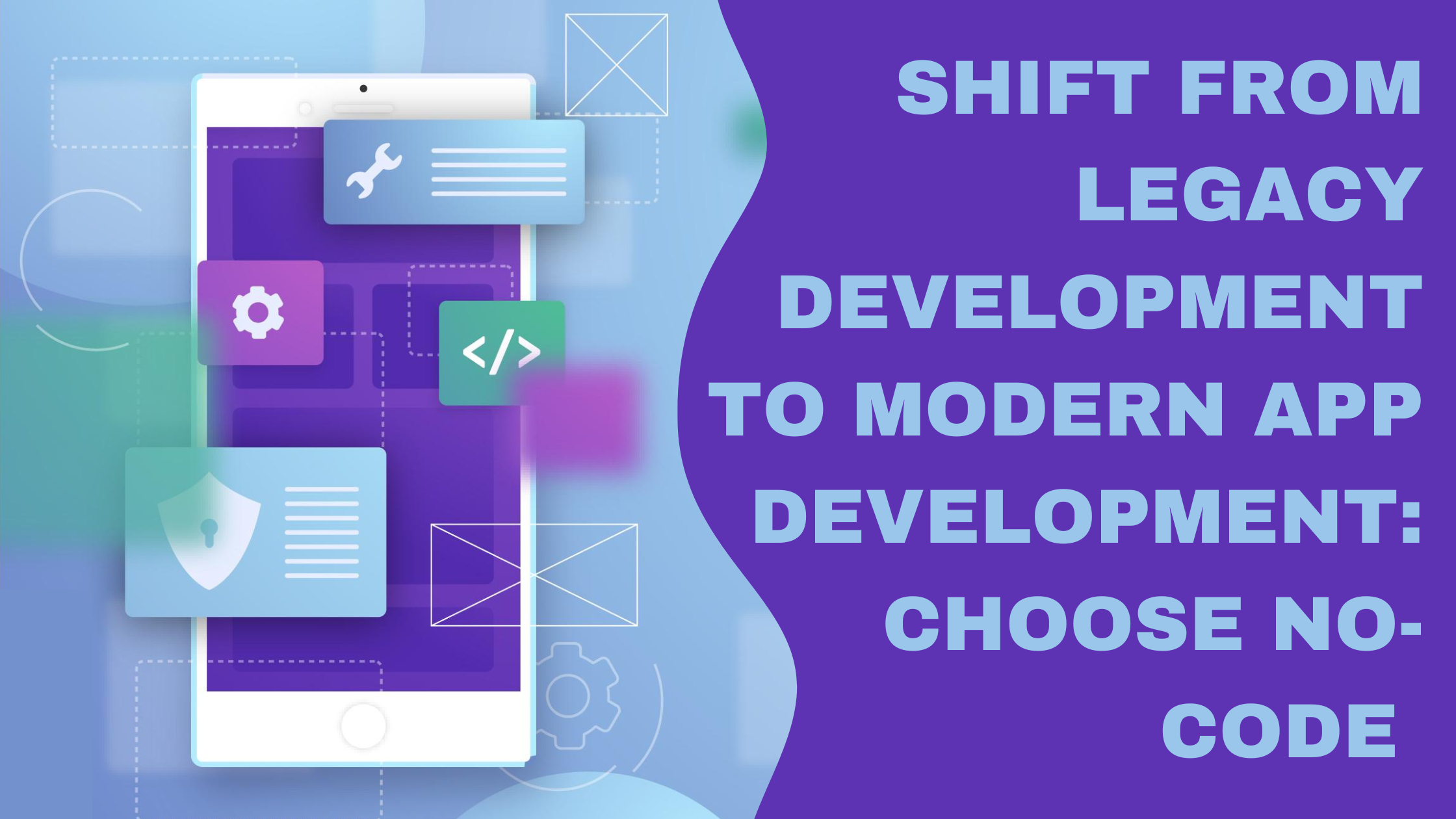Modern app development technologies like no-code/low-code, generative AI (Artificial Intelligence), machine learning, and others are transforming the landscape of app development. The drawbacks of legacy app development are somewhat overcome by modern app development solutions, so now is the right time to shift from traditional legacy app development and switch to modern app development solutions.
Businesses often invest heavily to buy or develop custom applications to facilitate essential business operations. Unfortunately, for any future app updates, businesses are heavily dependent upon legacy app developers, that is traditional coders. A company must pay more for every change and even take a long time to implement, which creates a disconnect with customers.
Modern app development solutions offer more comprehensive benefits such as platform flexibility, application scalability, agility, security, and cross-platform compatibility. This article delves into the benefits of shifting from Legacy Application to Modernization of app development process, related challenges, and how to create apps with modern app development solutions.
WHAT IS LEGACY APP DEVELOPMENT?
Legacy systems in life and P&C are built on outdated architectures with high maintenance costs, inherent inflexibility, redundant features, lack of connectivity, and low efficiency. Complex application and process logic is often hard-coded and undocumented.
Gartner
A legacy app system is a traditional piece of software, technology, or approach/language that a company still employs even if it has been replaced by more recent technology. Since the original vendors or producers no longer support them, maintaining and upgrading these systems can be expensive or complex. Integrating legacy systems with other systems is difficult because they are incompatible with current hardware or software platforms.
When applications start to present these typical problems, they become legacy app systems:
- Difficult and costly to maintain or update, and time-consuming too
- App performance issues, instability, or not being able to scale the app.
- The legacy app system may not interact with newer hardware
- The system is not agile to the changing customer needs
- No security updates and compliance risks
These are a few reasons why businesses should switch from traditional/ legacy app development to modern app development solutions.

A legacy system may be old-fashioned or complex, but it is not always outdated. Legacy systems can function at acceptable output levels and are crucial to the everyday operations of many businesses. They use the best application modernization technologies to maintain the functionality of their legacy software.
The need for digital transformation is fueling the rising demand for application modernization tools, which is expected to push the market value of this sector to $36.86 billion by 2027.
Businesses should think about modernizing legacy systems with modern programming languages and protocols after they reach a particular level of competence. In order to support an IT organization’s efforts in digital modernization, it is first crucial to comprehend the significance of legacy application modernization methodologies.
WHAT IS THE MODERNIZATION OF LEGACY APPLICATIONS?
What is legacy system modernization, one might wonder. The legacy app modernization procedure of taking a legacy system and updating it to integrate contemporary platform infrastructure, architecture, and/or features.
Depending on the status of the legacy system, the issues facing the organization, and the business objectives guiding the app modernization (and digital transformation), the road of application modernization can take many different turns. There are numerous modernization techniques to move, update, and optimize legacy systems to more contemporary architecture, therefore application modernization goes beyond simple replacement.
Using Legacy Application Modernization, existing software can be repurposed to run on modern devices and applications. Rebuilding these applications requires rewriting their source code, enhancing their functionality, or plugging them into a modern platform.
LEGACY APP DEVELOPMENT VS. MODERN APP DEVELOPMENT SYSTEMS

KEY REASONS TO MODERNIZE LEGACY APPLICATIONS
Keeping up with changing consumer needs is easier with legacy app modernization, which allows organizations to adopt modern technology and stay competitive. Modernizing apps has several key benefits for organizations:
Benefits of modernizing legacy apps for business aspect:
- Maintaining old legacy apps is costly, however, modernizing legacy apps reduces operational costs.
- Modernizing legacy apps provides a competitive advantage, enhanced app performance, scalability, and agility.
- Modernized Legacy Applications make apps efficient and flexible (different platforms)
- Improved customer satisfaction as legacy app modernization boosts performance and app UX (user experience).
Benefits of modernizing legacy apps for technical aspects:
- Simple API (Application Programming Interface) integration with other programs and third-party tools.
- Applications are protected from changing security risks by modernization.
- improved application performance with lowered security concerns and trustworthy procedures.
- enables the adoption of effective operating frameworks and methodologies, including DevOps.
HOW TO SHIFT A LEGACY APP TO THE CLOUD: LEGACY APP MODERNIZATION
While the best strategy for shifting from legacy apps to the cloud varies as per the organization, there are some common steps that can ensure a successful app modernization.
1. Assess the Existing Tech Stack
Organizations must carefully evaluate the effectiveness of the current system for business processes. To do this, a thorough assessment of linked applications and infrastructure is needed, which will eventually serve as the foundation for the migration strategy and determine whether the system is worth upgrading. Additionally, teams can streamline migration costs and efforts by using audits and assessments to determine which infrastructure or software no longer serves a purpose for the company.
Some important steps to include:
- A review of the high-level architecture and parts of the application to find roadblocks and choose the best migration plan.
- A thorough audit of the source code is performed to find bugs, vulnerabilities, and platform compatibility.
- To guarantee that user experiences are effortlessly transferred over and stay identical, UI/UX experts evaluate user interfaces, related procedures, and processes.
2. Choosing the app Modernization Approach
Deciding the right app modernization approach is the basic step before continuing the actual journey. As per the business case, one of the two approaches might be followed:
Disruptive:
In most cases, this legacy app modernization approach relates to a lift-and-shift method in which the entire application is re-hosted to the cloud in a single milestone. With this method, all the organization’s workloads may be quickly deployed to the cloud as the traditional platform is retired. The disruptive strategy has a quicker implementation time and is seen as ideal for businesses with less sophisticated, smaller workloads.
Phased:
The term “phased strategy” refers to a method in which the application workloads are moved to the cloud in a series of manageable milestones over time. This legacy app modernization strategy is seen to be appropriate for organizations with numerous business divisions and for large migration initiatives where training the workforce takes time. A phased approach additionally provides advantages like simpler change management and a decreased risk of failed migration.
3. Creating the Right Team
Organizations must prepare to onboard the right team of specialists who will guarantee flawless transitions from legacy apps to the cloud because operating an application on a cloud-native ecosystem demands specialized capabilities. This can be accomplished by retraining the company’s current employees, acquiring new personnel, or outsourcing the transition management to a third party. These professionals are in charge of identifying the workload components that need to be shifted as well as any potential difficulties.
Using the Agile model as part of the migration is a well-known strategy to guarantee a thorough and highly collaborative transformation. Organizations may effectively meet changing consumer expectations and achieve operational excellence with the correct Agile team structure.
4. Financial Planning
The costs of moving to the cloud must be taken into consideration by organizations. This usually involves an initial one-time payment for the change and recurring costs while using the cloud. The migration program should identify financial predictions for the pre-migration, migration, and post-migration stages when budgeting for a cloud-based legacy app modernization. By properly allocating resources for configuration and deployment, budgeting effectively enables organizations to reap the full benefits of cloud migration.
5. Choosing the Cloud Service
When shifting from legacy apps to cloud-based modern app development techniques, choose the right kind of cloud service for your business needs. You may choose any one out of the following three models:

IaaS (Infrastructure as a Service)
Infrastructure-as-a-Service (IaaS) enables organizations to get infrastructure resources on demand such as networks, storage, processors, and servers. Organizations only must pay for the infrastructure they actually use for their workloads, which can be increased later to meet the changes in resource demand.
Some popular IaaS include Microsoft’s Azure, Amazon’s Web Services (AWS), and Google Cloud Platform (GCP).
PaaS (Platform-as-a-Service)
Platform-as-a-Service enables businesses to concentrate on building code and automating deployment pipelines by letting cloud providers manage the hardware and operating systems. Efficiency is increased since complicated capacity planning, resource acquisition, and software maintenance are taken care of by PaaS.
Some popular PaaS include Windows Azure, AWS Elastic Beanstalk, and the Google App Engine.
SaaS (Software as a Service)
In Software-as-a-Service, the software providers develop apps to be offered over the web. With SaaS models, organizations only need to plan, develop and maintain the app for end-use, rather than maintaining the underlying infrastructure or related platform.
Some popular SaaS applications include Microsoft Dropbox, Google Workspace, Salesforce, and SAP Concur.
HOW TO USE SWING2APP TO SHIFT FROM LEGACY APP DEVELOPMENT TO MODERN APP DEVELOPMENT
Swing2App comes under SaaS service, where we provide you the software in the form of a no-code app development website. Here you just must plan the structure of your app and everything else is provided by the Swing2App no-code app builder.
Your entire application gets coded in the back end while you are visually creating the app using our website.
Rather than shifting later from legacy apps to the modernization of app development, choose Swing2App no-code app builder from the start. Here you can create no-code apps using the modern app development technique of no-code solution.
Most companies’ IT departments are overburdened. They have a massive backlog, and new requests for solutions never seem to stop coming in. That is why it is critical to empower citizen developers. They claim to have a solution for both budget and staffing issues, and all they need is a good no-code platform.
Swing2App’s citizen development platform is a simple work platform that will help you become a citizen developer quickly. It does not require extensive restructuring to use and contains a plethora of excellent tools that are simple to grasp. Sign up for a free trial today to get started building apps on a budget.
By using Swing2App, you have the ease and joy of creating an app on your own while maintaining your creativity.
Benefits of Using Swing2App:

Come up with a great idea and transform it into a brilliant app without any coding, only with Swing2App no-code app builder!
CONCLUSION
Organizations are increasingly adopting the cloud to modernize legacy applications since cloud computing offers rapid acceleration of organizational growth. According to a recent Gartner survey, which continues the current trend, roughly 70% of businesses that already use cloud services intend to raise their cloud investment in the future.
Traditionally, legacy programs that rely on slow, monolithic frameworks are run on-premises. As a result, legacy applications are unable to meet the new devices’ demands for agility and performance. Organizations must be aware of the obstacles and the best approach as they migrate to the cloud to enable digital transformation and modernize applications. However, the best migration plan is determined by the application’s type, the budget, and the demands of the company.
